Arianna Moccia
@arimoccia.bsky.social
620 followers
280 following
32 posts
Postdoc @yorkpsychology.bsky.social. Researching how, when, and what the brain remembers/forgets.
Posts
Media
Videos
Starter Packs
Pinned
Arianna Moccia
@arimoccia.bsky.social
· Jul 16

The Effects of External Cue Overlap and Internal Goals on Selective Memory Retrieval as Revealed by Electroencephalographic (EEG) Neural Pattern Reinstatement
This EEG study used multivariate decoding in humans to investigate how memories are selected when retrieval goals vary. The results showed that EEG neural patterns reinstating studied information tra...
doi.org
Reposted by Arianna Moccia
Reposted by Arianna Moccia
Reposted by Arianna Moccia
Alexa Morcom
@alexamorcom.bsky.social
· Jul 23
Arianna Moccia
@arimoccia.bsky.social
· Jul 16

The Effects of External Cue Overlap and Internal Goals on Selective Memory Retrieval as Revealed by Electroencephalographic (EEG) Neural Pattern Reinstatement
This EEG study used multivariate decoding in humans to investigate how memories are selected when retrieval goals vary. The results showed that EEG neural patterns reinstating studied information tra...
doi.org
Arianna Moccia
@arimoccia.bsky.social
· Jul 29
Reposted by Arianna Moccia
Aidan Horner
@aidanhorner.bsky.social
· Jul 29

A Meta-analytic Review of the Effectiveness of Spacing and Retrieval Practice for Mathematics Learning - Educational Psychology Review
Spaced retrieval practice harnesses two well-studied phenomena: the spacing effect, where spacing out practice over several sessions leads to a gain in retention compared to massed practice in one ses...
link.springer.com
Reposted by Arianna Moccia
Arianna Moccia
@arimoccia.bsky.social
· Jul 16
Arianna Moccia
@arimoccia.bsky.social
· Jul 16
Arianna Moccia
@arimoccia.bsky.social
· Jul 16
Arianna Moccia
@arimoccia.bsky.social
· Jul 16
Arianna Moccia
@arimoccia.bsky.social
· Jul 16
Arianna Moccia
@arimoccia.bsky.social
· Jul 16

The Effects of External Cue Overlap and Internal Goals on Selective Memory Retrieval as Revealed by Electroencephalographic (EEG) Neural Pattern Reinstatement
This EEG study used multivariate decoding in humans to investigate how memories are selected when retrieval goals vary. The results showed that EEG neural patterns reinstating studied information tra...
doi.org
Reposted by Arianna Moccia
Aidan Horner
@aidanhorner.bsky.social
· Nov 21
Arianna Moccia
@arimoccia.bsky.social
· Oct 15












